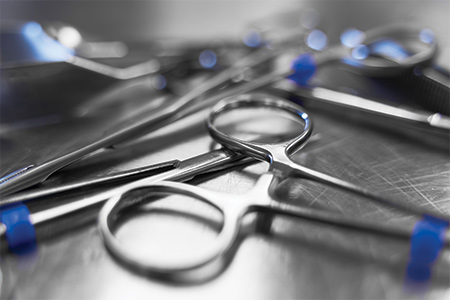Pet Bladder Surgery (Cystotomy)

We might also perform a cystotomy if we need to obtain a biopsy sample of the bladder. This can be the only way to determine if a tumor detected through an ultrasound is malignant.
Finally, a cystotomy can be used to repair certain types of trauma to the bladder, such as a ruptured bladder as the result of an accident.
How is the Surgery Performed?
Cystotomies require general anesthesia, so we will require certain medical tests before the day of surgery. These tests — including a full blood panel, a urinalysis, a urine culture, and sometimes an ultrasound or x-rays — are used to determine your pet’s overall health. This, in turn, helps us decide whether additional precautions need to be taken during the surgery. It also gives us a general idea of how well and quickly your pet will recover from the surgery. This is especially important for older or ill pets, as they might need special care during the pet bladder surgery and recovery.
The entire surgical process often takes as little as one hour, including the time needed to prepare and wait for the anesthetic to take effect. The surgery requires an incision into the caudal abdomen, similar to the one a female receives when spayed. Once the bladder is located, we can remove stones, perform a biopsy, remove a tumor, repair the injured area, and address anything else that requires attention.
Any internal incisions are then closed using dissolvable stitches. The exterior (skin) incision is closed using either dissolvable sutures or, in some cases, surgical staples or non-dissolvable sutures. These types of stitches will need to be removed about two weeks after the surgery. Your pet will likely need to wear an E-collar during this period if he starts to lick the incision or pull on the sutures.
Most pets also require the insertion of a urinary catheter during the surgery. This can be removed 2-3 days after the surgery. To ensure your pet is under supervision at all times, we recommend that he stays at the hospital until the catheter is removed. Some pets might need to stay longer if they are not recovering as quickly as expected. Pets that are feeling well and can go home should remain in a crate whenever possible to ensure that they don’t move around too much and accidentally reopen the incision.
Painkillers and antibiotics are usually prescribed to help your pet recover faster and avoid discomfort. Most pets feel relatively normal within a few days to a couple of weeks after the surgery.
Is a Cystotomy Dangerous?
Like with any surgery that requires general anesthesia, risks are always present. Aside from the risk of anesthesia, there’s also the risk of bleeding and urine leakage during or after the surgery. Although rare, an infection or the reopening of the wound might require additional surgery or treatment. We take every precaution and use top-of-the-line equipment to ensure your pet’s safety so the overall risk remains low.
If you are worried about potential complications or risks, please talk to us before you schedule the surgical appointment. We can answer any questions and help you figure out the best course of action to ensure the surgery and recovery are as smooth as possible.


